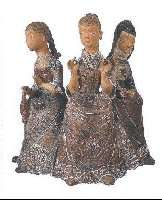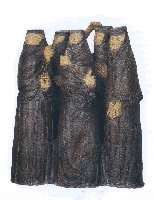|
Margit
Kovács
 For
me one of the most memorable parts of the Humanities trip to Eastern
Europe was our visit to a museum devoted to the works of Margit Kovács
in Szentendre.Without our native
guide, Réka, we might never have visited Szentendre, and I would never
have seen these works. Kovács’s
ceramic statues are wonderful and moving. Among my favorites of her works are The Fates and Fishermen’s
Wives. The subject of
The Fates is familiar to me from other artists’ works, but
Kovács portrays the three women in a folk art style. They are dressed in traditional Hungarian clothing, and each
represents a different stage of a woman’s life: Clotho is the young maid, Lachesis the matron, and Atropos is the crone.
There
is a simplicity and innocence to these women that is very appealing
and not necessarily the norm in presentations of the Fates. For
me one of the most memorable parts of the Humanities trip to Eastern
Europe was our visit to a museum devoted to the works of Margit Kovács
in Szentendre.Without our native
guide, Réka, we might never have visited Szentendre, and I would never
have seen these works. Kovács’s
ceramic statues are wonderful and moving. Among my favorites of her works are The Fates and Fishermen’s
Wives. The subject of
The Fates is familiar to me from other artists’ works, but
Kovács portrays the three women in a folk art style. They are dressed in traditional Hungarian clothing, and each
represents a different stage of a woman’s life: Clotho is the young maid, Lachesis the matron, and Atropos is the crone.
There
is a simplicity and innocence to these women that is very appealing
and not necessarily the norm in presentations of the Fates.
 Fishermen’s
Wives picks up on a theme of Hungarian life that we also saw in Budapest at the Fishermen’s Bastion on the Danube
River. This statue is
quite different from The Fates. Here innocence and quietude are replaced by worry. Life is not
simple or care free for these women who await the return of their
loved ones from the sea. Unlike
the women in The Fates, these women huddle together sharing
their concern, and at the same time each is wrapped in her cloak
isolated from the others. Their
worried expressions and tense poses are very moving and their fear is
starkly obvious at first glance. Fishermen’s
Wives picks up on a theme of Hungarian life that we also saw in Budapest at the Fishermen’s Bastion on the Danube
River. This statue is
quite different from The Fates. Here innocence and quietude are replaced by worry. Life is not
simple or care free for these women who await the return of their
loved ones from the sea. Unlike
the women in The Fates, these women huddle together sharing
their concern, and at the same time each is wrapped in her cloak
isolated from the others. Their
worried expressions and tense poses are very moving and their fear is
starkly obvious at first glance.
This
museum provided a wonderful taste of Hungarian art.
E-MAIL |